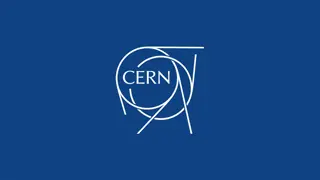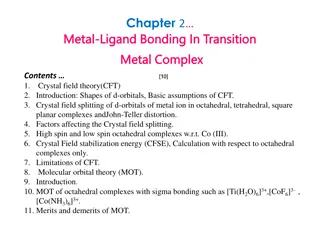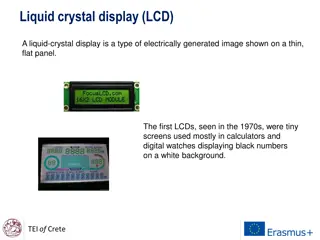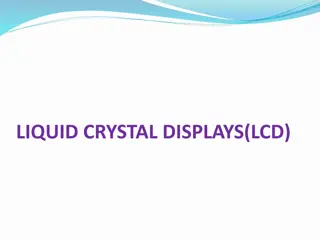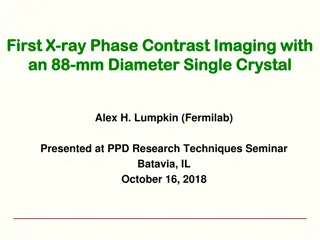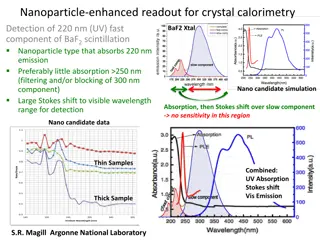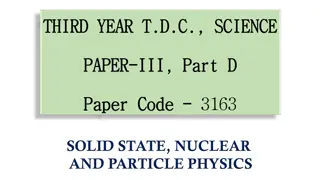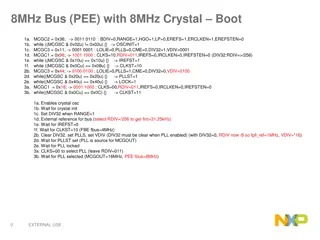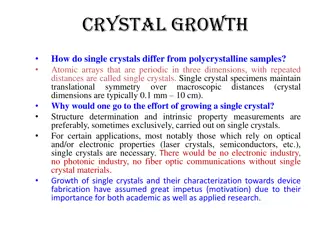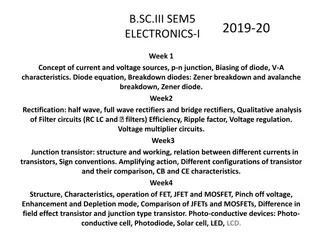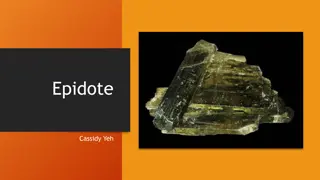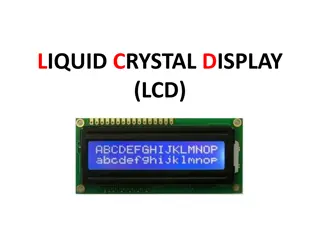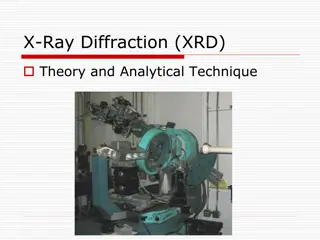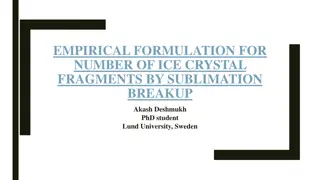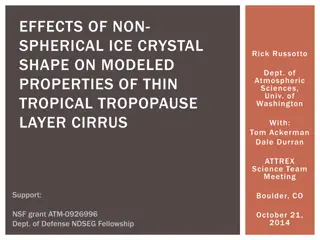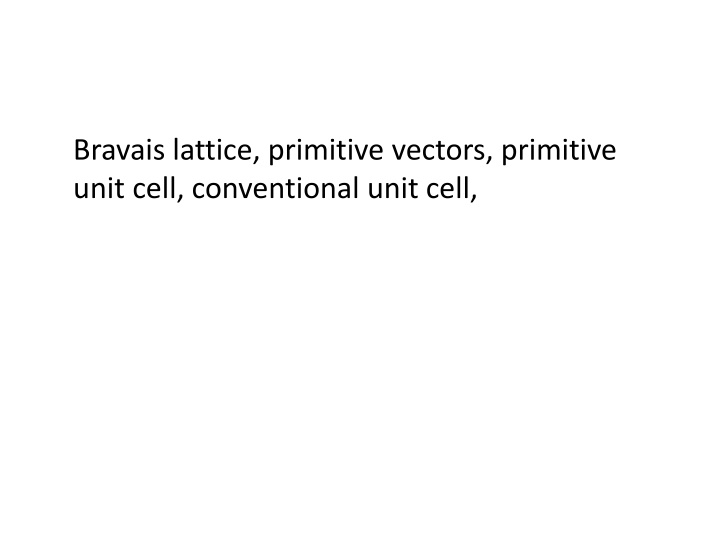
Crystal Lattice Structures and Unit Cells
Explore the concept of crystal lattice structures, including plane and space lattices, basis, and unit cells. Learn how atoms arrange in crystals and how unit cells help define crystal symmetry and structure.
Download Presentation

Please find below an Image/Link to download the presentation.
The content on the website is provided AS IS for your information and personal use only. It may not be sold, licensed, or shared on other websites without obtaining consent from the author. If you encounter any issues during the download, it is possible that the publisher has removed the file from their server.
You are allowed to download the files provided on this website for personal or commercial use, subject to the condition that they are used lawfully. All files are the property of their respective owners.
The content on the website is provided AS IS for your information and personal use only. It may not be sold, licensed, or shared on other websites without obtaining consent from the author.
E N D
Presentation Transcript
Bravais lattice, primitive vectors, primitive unit cell, conventional unit cell,
Plane Lattice Consider an array of points in such a way that the environment about any point environment about any other point. Such an array of points in two dimensions is shown in Fig. and is called a plane lattice. is identical with the For constructing a two dimensional lattice, choose any two convenient axis such that the points lie at equal intervals a and b along these axis as shown in the Fig. There are generally 5 lattices in two dimensions: Oblique, Square, Hexagonal, Rectangular and Centered Rectangular lattice.
Space Lattice If dimensions then the array of points is called space lattice. For constructing the space lattice the points are arranged at equal intervals c in the third direction also. There are 14 space lattices in total, called Bravais Lattice. this array of points is extended to three Thus a lattice may also be defined as a parallel net like arrangement of environment about any point is identical with the environment about any other point. points such that the
Basis A basis is defined as an assembly of atoms, ions or molecules identical in composition, arrangement and orientation. Basis consists of the simplest arrangement of atoms which is repeated at every point in the lattice to build up the crystal structure. The number of atoms in a basis may be one as in case of many metals and inert gases, but could be as large as 1000 in many structures. In ionic crystals, a basis is composed of two distinct types of ions. For example, Na+and Cl-in a NaCl crystal.
When basis is attached identically to each lattice point, the actual crystal structure is formed as shown in the Fig. The relation can be written as Lattice + Basis = Crystal Structure
UNIT CELL A unit cell is a region of space which when repeated by primitive translation vectors fills all space. unit cell is defined as the smallest geometrical figure, the repetitions of which structure. Thus a give the actual crystal The choice of the unit cell is not unique. It can be constructed in a number of ways, but the unit cell should be chosen in such a way that it conveys all the symmetry of a crystal lattice, by having shortest possible size, which makes the mathematical calculations easy. Each atom or molecule in a unit cell is considered as lattice point. The distance between the two atoms or ions of the same type is the length of the unit cell . a
Primitiv Primitive e and and Non Non - - primitive primitive unit unitcell cell A unit cell which contain just one lattice point is called primitive unit cell. This cell is the smallest part of the lattice which when repeated would reconstruct the entire crystal structure. It is a minimum volume unit cell and is denoted by the letter p. A unit cell which contain more than one lattice point is called non - primitive unit cell. These two cells are shown in the Fig.
For a three dimensional case, the unit cell is a parallelopiped formed by basic vectors a, b and c as concurrent edges and the angles , and , between (b, c), (c, a), and (a, b) respectively as explained in the following Figures.
Thus, in general, a unit cell may be defined as the smallest volume of a solid from which the entire crystal may be repetitions in 3-dimension and which represent fully all the characteristics of a particular crystal. In Fig. a three dimensional unit cell is shown by the shaded portion. constructed by translational
Lattice Parameters In a unit cell the vectors a, b and c are called vectors or vectors. In two dimensionsn the area of the unit cell is (a x b) while in three dimension the volume of the unit cell is (a x b).c . In Fig. the direction of the primitive defines the axis. The angles between these axis are called angles, which are , and , between (b, c), (c, a), and (a, b) respectively. Primitive vectors and interfacial angles together are called lattice parameters. translation primitive basis basis crystallographic vectors interfacial
CRYSTAL SYSTEMS AND BRAVAIS LATTICES Crystals of different substances have similar shapes and hence the crystals are classified into the so called crystal systems depending upon their axial ratio and the interfacial angles , and . In three-dimension, there are 7 crystal systems. Bravais showed that throughout the seven crystal systems there are fourteen unique lattice types possible. These are known as Bravais or space lattices. These seven crystal systems with examples are : Cubic(CsCl, NaCl, Cu) Tetragonal(SnO2) Orthorhombic(PbSO4, MgSO4) Monoclinic(FeSO4, LiSO4 H2O) Triclinic(FeSO4 5H2O,K2Cr2O7) Trigonal (Rhombohedral)(Sb, As, CaCO3) Hexagonal(Zn, Cd, Ni, As, SiO2) The characteristics features of these crystal systems and the corresponding Bravais lattices are as follows:
No. Crystal class Intercepts Bravais space lattice Angles between Axes on Axes 1 Cubic Simple, body-centred, face-centred Simple, body-centred a = b = c = = = 900 2 Tetragonal a = b c = = = 900 3 Orthorhombic a b c Simple, body-centred, face-centred, Base(side)-centred = = = 900 4 Trigonal Simple a = b = c = = 900 5 Hexagonal Simple a = b c = = 900, = 1200 = = 900 6 7 Monoclinic Triclinic Simple, base-centred Simple a b c a b c

